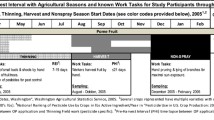Abstract
This study examined family use of pesticides in the home, garden, orchard, and yard. Data were collected from 238 families in Missouri during telephone interviews from June 1989 to March 1990.
Nearly all families (97.8%) used pesticides at least one time per year and two thirds used pesticides more than five times per year. More than 80% used pesticides during pregnancy and 70% used pesticides during the first 6 months of a child's life.
The most common setting for family pesticide use was in the home, where 80% of families used pesticides at least once per year. This was followed by herbicide use to control yard weeds (57% of families) and insecticide use to control fleas and ticks on pets (50% of families). A substantial number of families also used pesticides in the garden or orchard (33%).
Flea collars were the most popular pest control product (50% of families). Carbaryl or Sevin® was also popular, with 28.2% of families reporting use. No-pest-strips (dichlorvos) and Kwell® shampoo (lindane) were used by almost 10% of participating families.
Examination of study data revealed that families limited exposure to pesticides for the mother during pregnancy and for children during the first 6 months of life. Families failed to recognize and reduce pervasive exposures associated with no-pest-strips and flea collars.
Similar content being viewed by others
References
Bennett GW, Runstrom ES, Wieland JA (1983) Pesticide use in homes. Bull ESA 64:31–38
CDFA (1978) Report on Environmental Assessment of Pesticide Regulatory Programs. State Component, Vol 2. California Department of Food and Agriculture, Sacramento, CA
Davis JR (1991) Childhood cancer and pesticide use in the home, garden and yard. PhD Dissertation. University of California, Berkeley, CA
Edmundson WF, Davies JE, Maceo A, Morgade C (1979) Drug and environmental effects on DDT residues in human blood. South Med J 63:1440–1441
EPA (1989) Pesticides industry sales and usage, 1988 market estimates. Economic Analysis Branch, Biological and Economic Analysis Division, Office of Pesticide Programs. United States Environmental Protection Agency. Washington, DC
Finklea JF, Keil JE, Sandifer SH, Gadsden RH (1969) Pesticides and pesticide hazards in urban households. South Carolina Med Assoc 65:31–33
IARC (1979) IARC monographs on the evaluation of the carcinogenic risk of chemicals to humans. IARC 20:195–239
Immerman FW, Schaum JL (1990) Final report of the nonoccupational pesticide exposure study (NOPES). United States Environmental Protection Agency, Research Triangle Park, NC
Jurinski NB (1984) The evaluation of chlordane and heptachlor vapor concentrations within buildings treated for insect pest control. In: Indoor air: Proc 3rd Int Conf, Indoor Air Qual Clim Vol. #4. Stockholm, Sweden. Swed Counc Build Res Issue PB 85-104214, pp 51–56
Kamble ST, Gold RE, Parkhurst AM (1982) Nebraska residential pesticide use survey (1979 and 1980). Agricultural Experimental Station, University of Nebraska, Lincoln, NE
Kurtz DA, Bode WM (1985) Application exposure to the home gardener. Amer Chem Soc Symposium Series 273:139–161
National Coalition Against the Misuse of Pesticides (1987a) DDVP regulatory action based on oncogenic, non-oncogenic effects. Pesticide Toxic Chem News, October 1987, pp 20–22
--(1987b) NTP finds dichlorvos is carcinogenic. Pesticide Toxic Chem News, July 1987, pp 27–28
Savage EP (1980) National household pesticide usage study, 1976–1977 final report for US EPA. Colorado State University, Fort Collins, Colorado
Sharp DS, Eskenazi B (1986) Delayed health hazards of pesticide exposure. Ann Rev Public Health 7:441–471
Spear RC (1991) Recognized and possible exposures to pesticides. In: Hayes W (ed) Handbook of pesticide toxicology, Volume 1, Chapter 6. Academic Press, San Diego, CA
Stacey CI, Tatum T (1985) House treatment with organochlorine pesticides and their levels in human milk—Perth, Western Australia. Bull Environ Contam Toxicol 35:202–208
WHO (1986) Principles for evaluating health risks from chemicals during infancy and early childhood: The need for a special approach. Environmental Health Criteria 59. World Health Organization. Geneva, Switzerland, 73 pp
Wolff GL, Morrissey RL (1986) Increased responsiveness of lean pseudoagouti AVY/A female mice to lindane enhancement of lung and liver tumorigenesis (meeting abstract). Proc Annu Meet Am Assoc Cancer Res 27:138
Wright CG, Leidy RB (1982) Chlordane and heptachlor in the ambient air of houses treated for termites. Bull Environ Contam Toxicol 28:617–623
Author information
Authors and Affiliations
Rights and permissions
About this article
Cite this article
Davis, J.R., Brownson, R.C. & Garcia, R. Family pesticide use in the home, garden, orchard, and yard. Arch. Environ. Contam. Toxicol. 22, 260–266 (1992). https://doi.org/10.1007/BF00212083
Received:
Revised:
Issue Date:
DOI: https://doi.org/10.1007/BF00212083




